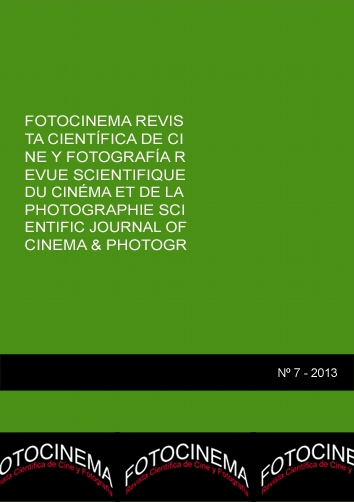La risa en La Ricotta de Pasolini
DOI:
https://doi.org/10.24310/Fotocinema.2013.v0i7.5930Abstract
El presente ejercicio teórico toma como objeto de su estudio la risa dentro de la narración cinema-tográfica a partir de un fragmento escogido del filme de Pasolini, La ricotta (1963).Para ello articularemos nuestro análisis en dos episodios: el primero dirigido al repaso teórico e histórico de la risa; el segundo, a la aplicación de las directrices metodológicas rescatadas del primero al análisis cinematográfico de nuestro caso de estudio.
Se trata de analizar el comporta-miento de la risa a partir de los elementos que componen la historia cinematográfica: los narrativos y los estilísticos. La finalidad del texto será la de estudiar la disyunción entre imagen fija e imagen movimiento tomando la risa como el punto de inflexión entre ambas.
Abstract:
This essay is based on the study of laughter in cinematic storytelling from a chosen fragment of Pasolini's film, La ricotta (1963). This paper will be structured in two stages: the first one related to theoretical and historical overview of laughter, and the second one on film analysis taking in consideration the previous concepts underlined at the first stage.
That means to analyse the behaviour of laughter through the elements that are involved in the construction of a film story: narratives elements and stylistic elements. The aim of this essay is to study the relationship between still image and moving image, taking laughter as the turning point between those types of images.
Palabras clave:
Risa; mecánico; viviente; imagen fija; imagen movimiento.
Keywords:
Laughter; mechanical; living; still image; moving image.Downloads
Metrics
Downloads
Published
How to Cite
Issue
Section
License
All contents published in Fotocinema Revista científica de cine y fotografía are protected under the Creative Commons Attribution-NonCommercial-ShareAlike 4.0 International (CC BY-NC-SA 4.0) license. All about this license is available in the following link: <http://creativecommons.org/licenses/by-nc-sa/4.0>
Users can copy, use, redistribute, share and exhibit publicly as long as:
- The original source and authorship of the material are cited (Journal, Publisher and URL of the work).
- It is not used for comercial purposes.
- The existence of the license and its especifications are mentioned.
There are two sets of authors’ rights: moral and property rights. Moral rights are perpetual prerogatives, unrenounceable, not-transferable, unalienable, imprescriptible and inembargable. According to authors’ rights legislation, Fotocinema. Revista científica de cine y fotografía recognizes and respects authors moral rights, as well as the ownership of property rights, which will be transferred to University of Malaga in open access. The property rights are referred to the benefits that are gained by the use or the dissemination of works. Fotocinema. Revista científica de cine y fotografía is published in an open access form and it is exclusively licenced by any means for doing or authorising distribution, dissemination, reproduction, , adaptation, translation or arrangement of works.
Authors are responsable for obtaining the necessary permission to use copyrighted images.













13.png)




